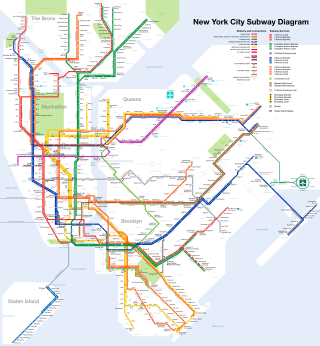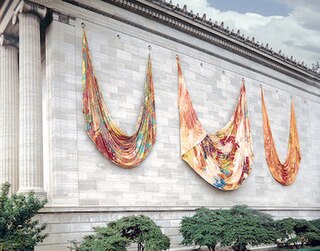
Visual art of the United States or American art is visual art made in the United States or by U.S. artists. Before colonization, there were many flourishing traditions of Native American art, and where the Spanish colonized Spanish Colonial architecture and the accompanying styles in other media were quickly in place. Early colonial art on the East Coast initially relied on artists from Europe, with John White the earliest example. In the late 18th and early 19th centuries, artists primarily painted portraits, and some landscapes in a style based mainly on English painting. Furniture-makers imitating English styles and similar craftsmen were also established in the major cities, but in the English colonies, locally made pottery remained resolutely utilitarian until the 19th century, with fancy products imported.

The Red Line is a rapid transit line operated by the Massachusetts Bay Transportation Authority (MBTA) as part of the MBTA subway system. The line runs south and east underground from Alewife station in North Cambridge through Somerville and Cambridge, surfacing to cross the Longfellow Bridge then returning to tunnels under Downtown Boston. It continues underground through South Boston, splitting into two branches on the surface at JFK/UMass station. The Ashmont branch runs southwest through Dorchester to Ashmont station, where the connecting light rail Mattapan Line continues to Mattapan station. The Braintree branch runs southeast through Quincy and Braintree to Braintree station.

The School of the Museum of Fine Arts at Tufts University is the art school of Tufts University, a private research university in Boston, Massachusetts. It offers undergraduate and graduate degrees dedicated to the visual arts.

Davis Square is a major intersection in the northwestern section of Somerville, Massachusetts, United States, where several streets meet: Holland Street, Dover Street, Day Street, Elm Street, Highland Avenue, and College Avenue. The name is often used to refer to the West Somerville neighborhood surrounding the square as well.

Color field painting is a style of abstract painting that emerged in New York City during the 1940s and 1950s. It was inspired by European modernism and closely related to abstract expressionism, while many of its notable early proponents were among the pioneering abstract expressionists. Color field is characterized primarily by large fields of flat, solid color spread across or stained into the canvas creating areas of unbroken surface and a flat picture plane. The movement places less emphasis on gesture, brushstrokes and action in favor of an overall consistency of form and process. In color field painting "color is freed from objective context and becomes the subject in itself."

Alewife station is a Massachusetts Bay Transportation Authority (MBTA) intermodal transit station in the North Cambridge neighborhood of Cambridge, Massachusetts. It is the northwest terminal of the rapid transit Red Line and a hub for several MBTA bus routes. The station is at the confluence of the Minuteman Bikeway, Alewife Linear Park, Fitchburg Cutoff Path, and Alewife Greenway off Alewife Brook Parkway adjacent to Massachusetts Route 2, with a five-story parking garage for park and ride use. The station has three bike cages. Alewife station is named after nearby Alewife Brook Parkway and Alewife Brook, themselves named after the alewife fish.

Porter station is a Massachusetts Bay Transportation Authority (MBTA) transit station in Cambridge, Massachusetts. It serves the Red Line rapid transit line, the MBTA Commuter Rail Fitchburg Line, and several MBTA bus lines. Located at Porter Square at the intersection of Massachusetts and Somerville Avenues, the station provides rapid transit access to northern Cambridge and the western portions of Somerville. Porter is 14 minutes from Park Street on the Red Line, and about 10 minutes from North Station on commuter rail trains. Several local MBTA bus routes also stop at the station.

Davis station is an underground Massachusetts Bay Transportation Authority (MBTA) Red Line rapid transit station located at Davis Square in Somerville, Massachusetts. The accessible station has a single island platform for the Red Line, as well as a dedicated busway on the surface. It opened in 1984 as part of the Red Line Northwest Extension project.

Kendall/MIT station is an underground rapid transit station in Cambridge, Massachusetts. It is served by the MBTA Red Line. Located at the intersection of Main Street and Broadway, it is named for the primary areas it serves - the Kendall Square business district and the Massachusetts Institute of Technology (MIT). Opened in March 1912 as part of the original Cambridge subway, Kendall/MIT has two side platforms serving the line's two tracks. The Kendall Band, a public art installation of hand-operated musical sculptures, is located between the tracks in the station with controls located on the platforms. Kendall/MIT station is accessible. With 17,018 weekday boardings by a FY2019 count, Kendall/MIT has the fourth highest ridership among MBTA subway stations.

The New York City Subway is a rapid transit system that serves four of the five boroughs of New York City, New York: the Bronx, Brooklyn, Manhattan, and Queens. Its operator is the New York City Transit Authority, which is itself controlled by the Metropolitan Transportation Authority of New York. In 2015, an average of 5.65 million passengers used the system daily, making it the busiest rapid transit system in the United States and the 11th busiest in the world.

Ellsworth Kelly was an American painter, sculptor, and printmaker associated with hard-edge painting, Color field painting and minimalism. His works demonstrate unassuming techniques emphasizing line, color and form, similar to the work of John McLaughlin and Kenneth Noland. Kelly often employed bright colors. He lived and worked in Spencertown, New York.

Sam Gilliam was an American abstract painter, sculptor, and arts educator. Born in Mississippi, and raised in Kentucky, Gilliam spent his entire adult life in Washington, D.C., eventually being described as the "dean" of the city's arts community. Originally associated with the Washington Color School, a group of Washington-area artists that developed a form of abstract art from color field painting in the 1950s and 1960s, Gilliam moved beyond the group's core aesthetics of flat fields of color in the mid-60s by introducing both process and sculptural elements to his paintings.

Broadway station is a subway station in Boston, Massachusetts. It serves the MBTA's Red Line. It is located at the intersection of Dorchester Avenue and Broadway in South Boston. It was opened on December 15, 1917, as part of the Dorchester Extension from Downtown Crossing to Andrew. The station has a single island platform to serve the two tracks.

Flamingo, created by noted American artist Alexander Calder, is a 53-foot-tall (16 m) stabile located in the Federal Plaza in front of the Kluczynski Federal Building in Chicago, Illinois, United States. It was commissioned by the United States General Services Administration and was unveiled in 1974, although Calder's signature on the sculpture indicates it was constructed in 1973.
Mel Kendrick is an American visual artist and sculptor known primarily for his abstract, three-dimensional forms derived from sliced and reconstituted wooden blocks. Kendrick's work is understood to reflect a deep fascination with process, space, geometry, and natural forms and materials.

Arts on the Line was a program devised to bring art into the Massachusetts Bay Transportation Authority (MBTA) subway stations in the late 1970s and early 1980s. Arts on the Line was the first program of its kind in the United States and became the model for similar drives for art across the country. The first twenty artworks were completed in 1985 with a total cost of US$695,000, or one half of one percent of the total construction cost of the Red Line Northwest Extension, of which they were a part.

Gift of the Wind is a large-scale public kinetic sculpture, by Susumu Shingu, located in Porter Square, Cambridge, Massachusetts at the Porter, Massachusetts Bay Transportation Authority subway and commuter rail station. The artwork consists of a tall white pole with three red "wings" attached to the top that are "designed to shift in response to the movement of the wind, not only turning clockwise and counterclockwise, but tumbling over and over in various sequences". It is considered by some to be "Cambridge's most visible landmark".

The Davis Square statues, entitled Ten Figures, are life-sized cast concrete public sculpture, created by James Tyler in 1983, located in Davis Square, Somerville, Massachusetts at or near the Davis, Massachusetts Bay Transportation Authority subway station. The statues are mostly based on people who lived near Davis Square in the 1980s. In 1996 bronze "masks" were added to the sculptures to repair damage and deter future vandalism.

Glove Cycle is a 1984 public art installation by Mags Harries, located throughout the Massachusetts Bay Transportation Authority Porter subway and commuter rail station in Porter Square, Cambridge, Massachusetts. The artwork consists of 54 separate bronze pieces and was created with a budget of US$30,000.

Draped paintings are paintings on unstretched canvas or fabric that are hung, tied, or draped from individual points and allowed to bunch or fold. The style was developed in the late 1960s and 1970s by several groups of artists, and popularized most notably by American artist Sam Gilliam, who created a large number of Drape paintings throughout his career, often as large-format installation pieces designed to fill an entire wall or space.




















